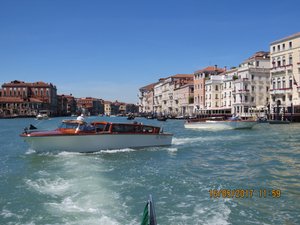Advertisement
Published: June 22nd 2017

 The Grand Canal
The Grand Canal
Another beautiful day!Geo: 45.4343, 12.339
Venice comprises 118 islands connected by 400 bridges. For ten centuries (until conquered by Napoleon) Venice was a republic with a figurehead Doge (Duke) elected by the Senate. Napoleon gave Venice to the Austrians and Venice then became part of the Unified Italy in 1866.
We said farewell to our coach and water-taxied into the city. After lunch we toured the Doge's Palace then checked in to our hotel - the Gritti Palace on the Grand Canal, two 'blocks' from St Mark's square.
In the evening we had an exclusive after-hours tour of St Mark's Basilica. It was pretty special. We were the only tourists in the church and they turned on the lights for us and our guides showed us around pretty much everywhere.
Advertisement
Tot: 0.118s; Tpl: 0.01s; cc: 8; qc: 23; dbt: 0.0993s; 1; m:domysql w:travelblog (10.17.0.13); sld: 1;
; mem: 1.1mb

 The Grand Canal
The Grand Canal










